fuel pressure HONDA PRELUDE 1998 Owners Manual
[x] Cancel search | Manufacturer: HONDA, Model Year: 1998, Model line: PRELUDE, Model: HONDA PRELUDE 1998Pages: 278, PDF Size: 2.61 MB
Page 52 of 278
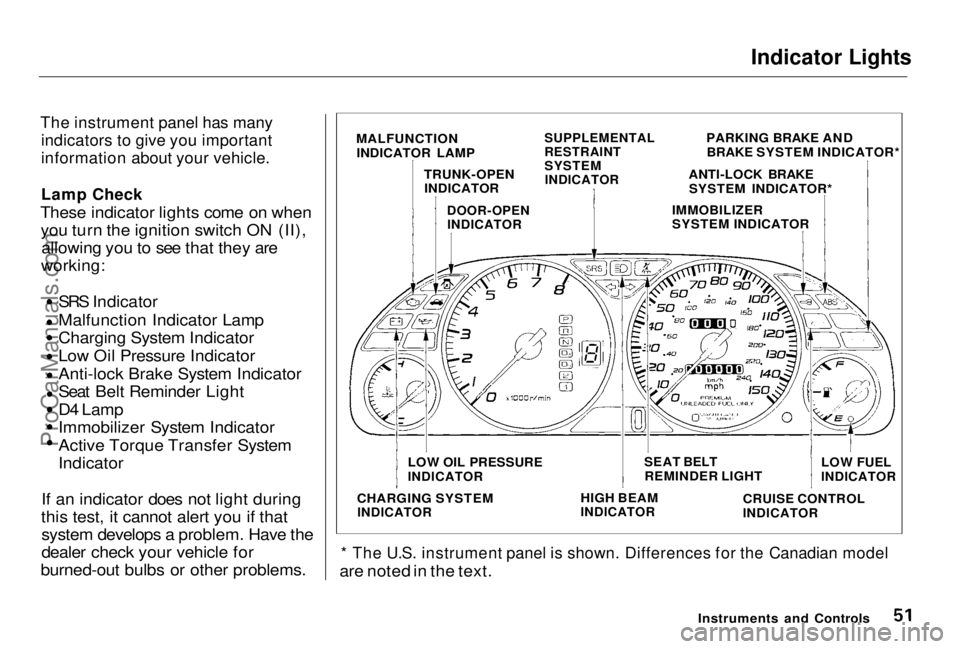
Indicator Lights
The instrument panel has many indicators to give you important
information about your vehicle.
Lamp Chec
k
These indicator lights come on when you turn the ignition switch ON (II), allowin
g you to see that they are
working:
SRS
Indicator
Malfunction Indicator Lamp
Charging System Indicator Low Oil Pressure Indicator
Anti-lock Brake System Indicator
Seat Belt Reminder Light
D4 Lamp
Immobilizer System Indicator
Active Torque Transfer
System
Indicator
If an
indicator does not light during
this test, it cannot alert you if that system
develops a problem. Have the
dealer check your vehicle for
burned-ou
t bulbs or other problems.
* The
U.S. instrument panel is shown. Differences for the Canadian model
are
noted in the text.
Instruments
and Controls
MALFUNCTION
INDICATOR LAM
P
TRUNK-OPEN INDICATOR
SUPPLEMENTAL
RESTRAINT
SYSTEM
INDICATOR
DOOR-OPEN
INDICATOR
PARKING BRAKE AND
BRAKE SYSTEM INDICATOR*
ANTI-LOCK BRAKE SYSTEM INDICATOR*
IMMOBILIZER
SYSTEM INDICATOR
LOW OIL PRESSURE
INDICATOR
SEAT BELT
REMINDER LIGHT LOW
FUEL
INDICATOR
CHARGING SYSTEM
INDICATOR
HIGH
BEAM
INDICATOR
CRUISE CONTRO L
INDICATOR
ProCarManuals.comMain Menu Table of Contents s t
Page 53 of 278
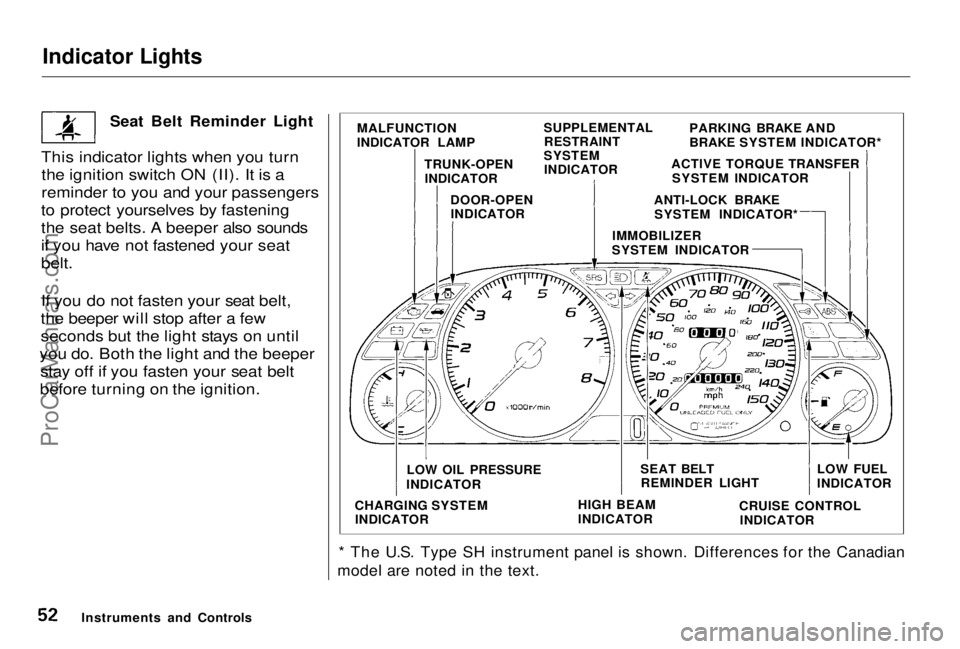
Indicator Lights
Seat Belt Reminder Light
This indicator lights when you turn the ignition switch ON (II). It is a
reminder to you and your passengers
to protect yourselves by fastening
the seat belts. A beeper also sounds
if you have not fastened your seat
belt.
If you do not fasten your seat belt,
the beeper will stop after a few
seconds but the light stays on until
you do. Both the light and the beeper stay off if you fasten your seat belt
before turning on the ignition.
* The U.S. Type SH instrument panel is shown. Differences for the Canadian
model are noted in the text.
Instruments and Controls MALFUNCTION
INDICATOR LAMP
SUPPLEMENTAL
RESTRAINT
SYSTEM INDICATOR
TRUNK-OPEN
INDICATOR
DOOR-OPENINDICATOR PARKING BRAKE AND
BRAKE SYSTEM INDICATOR*
ACTIVE TORQUE TRANSFER SYSTEM INDICATOR
ANTI-LOCK BRAKE SYSTEM INDICATOR*
IMMOBILIZER
SYSTEM INDICATOR
LOW OIL PRESSURE
INDICATOR
CHARGING SYSTEM INDICATOR SEAT BELT
REMINDER LIGHT
HIGH BEAM
INDICATOR LOW FUEL
INDICATOR
CRUISE CONTROL INDICATORProCarManuals.comMain Menu Table of Contents s t
Page 121 of 278
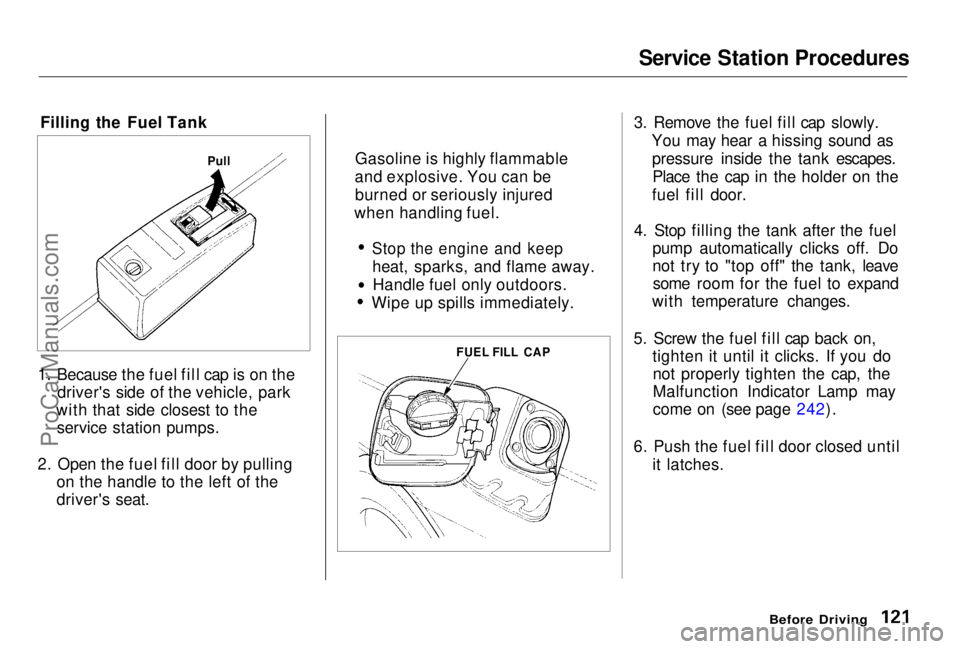
Service Station Procedures
Filling the Fuel Tank
1. Because the fuel fill cap is on the driver's side of the vehicle, park
with that side closest to the service station pumps.
2. Open the fuel fill door by pulling on the handle to the left of the
driver's seat. 3. Remove the fuel fill cap slowly.
You may hear a hissing sound aspressure inside the tank escapes.Place the cap in the holder on the
fuel fill door.
4. Stop filling the tank after the fuel pump automatically clicks off. Do
not try to "top off" the tank, leavesome room for the fuel to expand
with temperature changes.
5. Screw the fuel fill cap back on, tighten it until it clicks. If you donot properly tighten the cap, the
Malfunction Indicator Lamp may
come on (see page 242).
6. Push the fuel fill door closed until it latches.
Before Driving
Pull
FUEL FILL CAP
Gasoline is highly flammable
and explosive. You can be burned or seriously injured
when handling fuel.
Stop the engine and keep
heat, sparks, and flame away.Handle fuel only outdoors.
Wipe up spills immediately.ProCarManuals.comMain Menu Table of Contents s t
Page 125 of 278

Fuel Economy
The condition of your vehicle and your driving habits are the two most important things that affect the fuel
mileage you get.
Vehicle Condition Always maintain your vehicle accord- ing to the maintenance schedule.
This will keep it in top operating condition.
An important part of that mainte- nance is the Owner MaintenanceChecks (see page 171). For
example, an underinflated tire
causes more "rolling resistance,"
which uses fuel. It also wears out
faster, so check the tire pressure at
least monthly.
In winter, the build-up of snow on
your vehicle's underside adds weight and rolling resistance. Frequent
cleaning helps your fuel mileage and
reduces the chance of corrosion. Driving Habits
You can improve fuel economy by driving moderately. Rapid acceler-
ation, abrupt cornering, and hard
braking use more fuel.
Always drive in the highest gear that allows the engine to run and acceler-
ate smoothly.
Depending on traffic conditions, try
to maintain a constant speed. Every
time you slow down and speed up,
your vehicle uses extra fuel. Use the cruise control, when appropriate, to
increase fuel economy. A cold engine uses more fuel than a
warm engine. It is not necessary to "warm-up" a cold engine by letting it
idle for a long time. You can drive
away in about a minute, no matter
how cold it is outside. The engine
will warm up faster, and you get better fuel economy. To cut down on
the number of "cold starts," try tocombine several short trips into one.
The air conditioning puts an extra load on the engine which makes ituse more fuel. Turn off the A/C to
cut down on air conditioning use.
Use the flow-through ventilation
when the outside air temperature ismoderate.
Before DrivingProCarManuals.comMain Menu Table of Contents s t
Page 170 of 278

Owner Maintenance Checks
You should check the following items at the specified intervals. If
you are unsure of how to perform any check, turn to the page given. Engine oil level — Check every
time you fill the fuel tank. See page 123. Engine coolant level — Check the
radiator reserve tank every time
you fill the fuel tank. See page 124.
Windshield washer fluid — Check
the level in the reservoir monthly.If weather conditions cause you to
use the washers frequently, check
the reservoir each time you stop
for fuel. See page 182. Automatic transmission — Check
the fluid level monthly. See page
183.
Brakes — Check the fluid level
monthly. See page 185. Tires — Check the tire pressure
monthly. Examine the tread for
wear and foreign objects. See page
197.
Lights — Check the operation of
the headlights, parking lights,
taillights, high-mount brake light,
turn signals, brake lights, and
license plate lights monthly. See
page 203.
MaintenanceProCarManuals.comMain Menu Table of Contents s t
Page 196 of 278

Tires
To safely operate your vehicle, your tires must be the proper type and
size, in good condition with adequate
tread, and correctly inflated. The
following pages give more detailed information on how and when to
check air pressure, how to inspect
your tires for damage and wear, and
what to do when your tires need to
be replaced.
Inflation
Keeping the tires properly inflated
provides the best combination of
handling, tread life and riding comfort. Underinflated tires wear
unevenly, adversely affect handlingand fuel economy, and are more
likely to fail from being overheated. Overinflated tires can make your
vehicle ride more harshly, are more prone to damage from road hazards,and wear unevenly.
We recommend that you visually check your tires every day. If you
think a tire might be low, check it immediately with a tire gauge.
Use a gauge to measure the air
pressure at least once a month. Even
tires that are in good condition may
lose one to two psi (10 to 20 kPa, 0.1
to 0.2 kgf/cm2) per month. Remember to check the spare tire at
the same time you check all the other tires. Check the pressure in the tires when
they are cold. This means the vehicle
has been parked for at least three
hours. If you have to drive the
vehicle before checking the tire pressure, the tires can still be
considered "cold" if you drive less
than 1 mile (1.6km).
If you check the pressure when the
tires are hot (the vehicle has been driven several miles), you will see
readings 4 to 6 psi (30 to 40 kPa, 0.3
to 0.4 kgf/cm2) higher than the cold
reading. This is normal. Do not let air out to match the specified cold
pressure. The tire will be
underinflated.
You should get your own tire pressure gauge and use it whenever
you check your tire pressures. This
will make it easier for you to tell if a pressure loss is due to a tire problemand not due to a variation between
gauges.
Maintenance
CONTINUED
Using tires that are excessively
worn or improperly inflated can
cause a crash in which you can
be seriously hurt or killed.
Follow all instructions in this
owner's manual regarding tire
inflation and maintenance.ProCarManuals.comMain Menu Table of Contents s t
Page 248 of 278
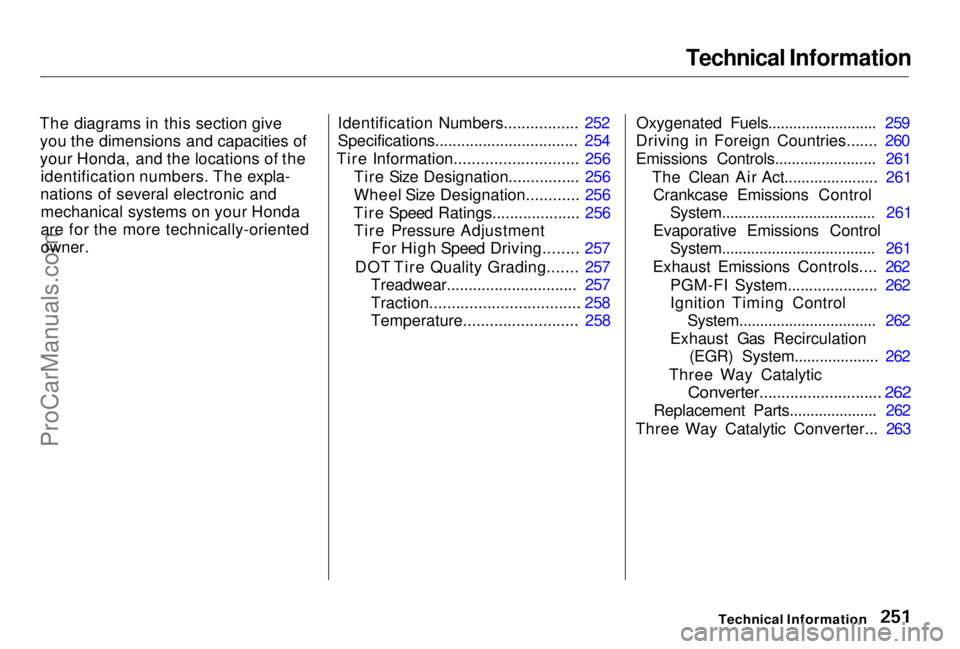
Technical Information
The diagrams in this section give you the dimensions and capacities of
your Honda, and the locations of the identification numbers. The expla-
nations of several electronic and mechanical systems on your Honda
are for the more technically-oriented
owner. Identification Numbers................. 252
Specifications................................. 254
Tire Information............................ 256 Tire Size Designation................ 256
Wheel Size Designation............ 256
Tire Speed Ratings.................... 256 Tire Pressure Adjustment For High Speed Driving........ 257
DOT Tire Quality Grading....... 257 Treadwear.............................. 257
Traction.................................. 258
Temperature.......................... 258 Oxygenated Fuels.......................... 259
Driving in Foreign Countries....... 260
Emissions Controls........................ 261
The Clean Air Act...................... 261Crankcase Emissions Control System..................................... 261
Evaporative Emissions Control System..................................... 261
Exhaust Emissions Controls.... 262 PGM-FI System..................... 262
Ignition Timing ControlSystem................................. 262
Exhaust Gas Recirculation (EGR) System.................... 262
Three Way Catalytic
Converter............................ 262
Replacement Parts..................... 262
Three Way Catalytic Converter... 263
Technical InformationProCarManuals.comMain Menu s t
Page 271 of 278
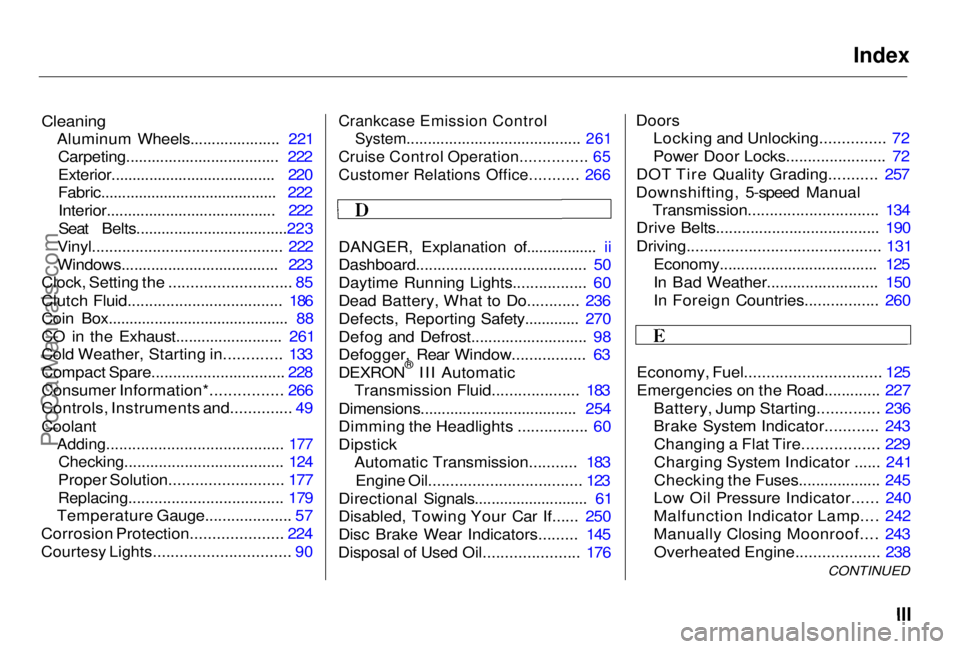
Index
Cleaning
Aluminum Wheels..................... 221Carpeting.................................... 222
Exterior....................................... 220
Fabric.......................................... 222
Interior........................................ 222
Seat Belts....................................223
Vinyl............................................ 222
Windows..................................... 223
Clock, Setting the ............................ 85
Clutch Fluid.................................... 186
Coin Box........................................... 88
CO in the Exhaust......................... 261
Cold Weather, Starting in............. 133
Compact Spare............................... 228
Consumer Information*................ 266
Controls, Instruments and.............. 49
Coolant
Adding......................................... 177
Checking..................................... 124
Proper Solution.......................... 177
Replacing.................................... 179
Temperature Gauge.................... 57
Corrosion Protection..................... 224
Courtesy Lights............................... 90
Crankcase Emission Control
System......................................... 261
Cruise Control Operation............... 65
Customer Relations Office........... 266
DANGER, Explanation of................. ii
Dashboard........................................ 50
Daytime Running Lights................. 60
Dead Battery, What to Do............ 236
Defects, Reporting Safety............. 270
Defog and Defrost........................... 98
Defogger, Rear Window................. 63
DEXRON ®
III Automatic
Transmission Fluid.................... 183
Dimensions..................................... 254
Dimming the Headlights ................ 60
Dipstick Automatic Transmission........... 183
Engine Oil................................... 123
Directional Signals........................... 61
Disabled, Towing Your Car If...... 250
Disc Brake Wear Indicators......... 145
Disposal of Used Oil...................... 176 Doors
Locking and Unlocking............... 72
Power Door Locks....................... 72
DOT Tire Quality Grading........... 257
Downshifting, 5-speed Manual Transmission.............................. 134
Drive Belts...................................... 190
Driving............................................ 131
Economy..................................... 125
In Bad Weather.......................... 150
In Foreign Countries................. 260
Economy, Fuel............................... 125
Emergencies on the Road............. 227 Battery, Jump Starting.............. 236
Brake System Indicator............ 243Changing a Flat Tire................. 229
Charging System Indicator ...... 241
Checking the Fuses................... 245
Low Oil Pressure Indicator...... 240
Malfunction Indicator Lamp.... 242
Manually Closing Moonroof.... 243
Overheated Engine................... 238 CONTINUEDProCarManuals.comMain Menu s t
Page 272 of 278
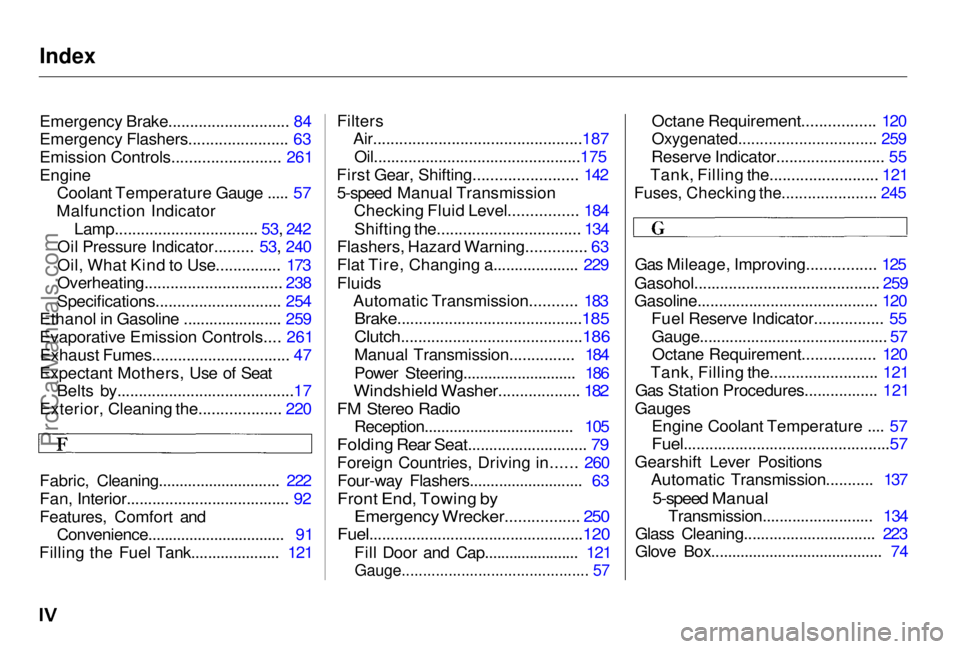
Index
Emergency Brake............................ 84
Emergency Flashers....................... 63
Emission Controls......................... 261
Engine
Coolant Temperature Gauge ..... 57
Malfunction Indicator Lamp................................. 53, 242
Oil Pressure Indicator......... 53, 240
Oil, What Kind to Use............... 173
Overheating................................ 238
Specifications............................. 254
Ethanol in Gasoline ....................... 259
Evaporative Emission Controls.... 261
Exhaust Fumes................................ 47
Expectant Mothers, Use of Seat Belts by.........................................17
Exterior, Cleaning the................... 220
Fabric, Cleaning............................. 222
Fan, Interior...................................... 92
Features, Comfort and Convenience................................. 91
Filling the Fuel Tank..................... 121 Filters
Air................................................187
Oil................................................175
First Gear, Shifting........................ 142 5-speed Manual Transmission Checking Fluid Level................ 184
Shifting the................................. 134
Flashers, Hazard Warning.............. 63
Flat Tire, Changing a.................... 229
Fluids Automatic Transmission........... 183
Brake...........................................185
Clutch..........................................186
Manual Transmission............... 184
Power Steering........................... 186
Windshield Washer................... 182
FM Stereo Radio
Reception.................................... 105
Folding Rear Seat............................ 79
Foreign Countries, Driving in...... 260 Four-way Flashers........................... 63
Front End, Towing by
Emergency Wrecker................. 250
Fuel..................................................120
Fill Door and Cap....................... 121
Gauge............................................ 57
Octane Requirement................. 120
Oxygenated................................ 259
Reserve Indicator......................... 55
Tank, Filling the......................... 121
Fuses, Checking the...................... 245
Gas Mileage, Improving................ 125
Gasohol........................................... 259
Gasoline.......................................... 120 Fuel Reserve Indicator................ 55
Gauge............................................ 57Octane Requirement................. 120
Tank, Filling the......................... 121
Gas Station Procedures................. 121
Gauges
Engine Coolant Temperature .... 57
Fuel................................................57
Gearshift Lever Positions Automatic Transmission........... 137
5-speed Manual
Transmission.......................... 134
Glass Cleaning............................... 223
Glove Box......................................... 74ProCarManuals.comMain Menu s t
Page 274 of 278
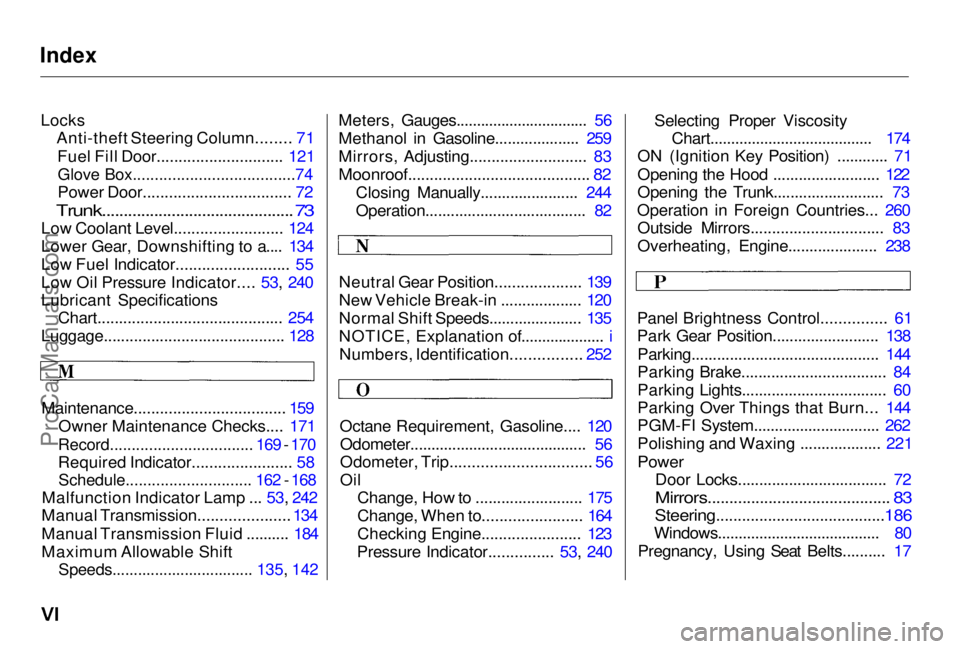
Index
Locks Anti-theft Steering Column........ 71
Fuel Fill Door............................. 121
Glove Box.....................................74
Power Door.................................. 72
Trunk............................................
73
Low Coolant
Level......................... 124
Lower Gear, Downshifting to a.... 134
Low Fuel Indicator.......................... 55
Low Oil Pressure Indicator.... 53, 240
Lubricant Specifications Chart........................................... 254
Luggage.......................................... 128
Maintenance................................... 159 Owner Maintenance Checks.... 171
Record................................. 169 - 170
Required Indicator....................... 58
Schedule............................. 162 -
168
Malfunction Indicator
Lamp ... 53,
242
Manual Transmission.....................
134
Manual Transmission
Fluid .......... 184
Maximum Allowable Shift
Speeds................................. 135, 142
Meters, Gauges................................ 56
Methanol in Gasoline.................... 259
Mirrors, Adjusting........................... 83
Moonroof.......................................... 82
Closing Manually....................... 244
Operation...................................... 82
Neutral Gear Position.................... 139
New Vehicle Break-in ................... 120
Normal Shift Speeds...................... 135
NOTICE, Explanation of.................... i Numbers, Identification................ 252
Octane Requirement, Gasoline.... 120Odometer.......................................... 56
Odometer, Trip................................ 56
Oil Change, How to ......................... 175
Change, When to....................... 164
Checking Engine....................... 123
Pressure Indicator............... 53, 240 Selecting Proper Viscosity
Chart....................................... 174
ON (Ignition Key Position) ............ 71
Opening the Hood ......................... 122
Opening the Trunk.......................... 73
Operation in Foreign Countries... 260 Outside Mirrors............................... 83
Overheating, Engine..................... 238
Panel Brightness Control............... 61
Park Gear Position......................... 138 Parking............................................ 144
Parking Brake.................................. 84
Parking Lights.................................. 60
Parking Over Things that Burn... 144
PGM-FI System.............................. 262
Polishing and Waxing ................... 221
Power
Door Locks................................... 72
Mirrors.......................................... 83
Steering.......................................186
Windows....................................... 80
Pregnancy, Using Seat Belts.......... 17ProCarManuals.comMain Menu s t